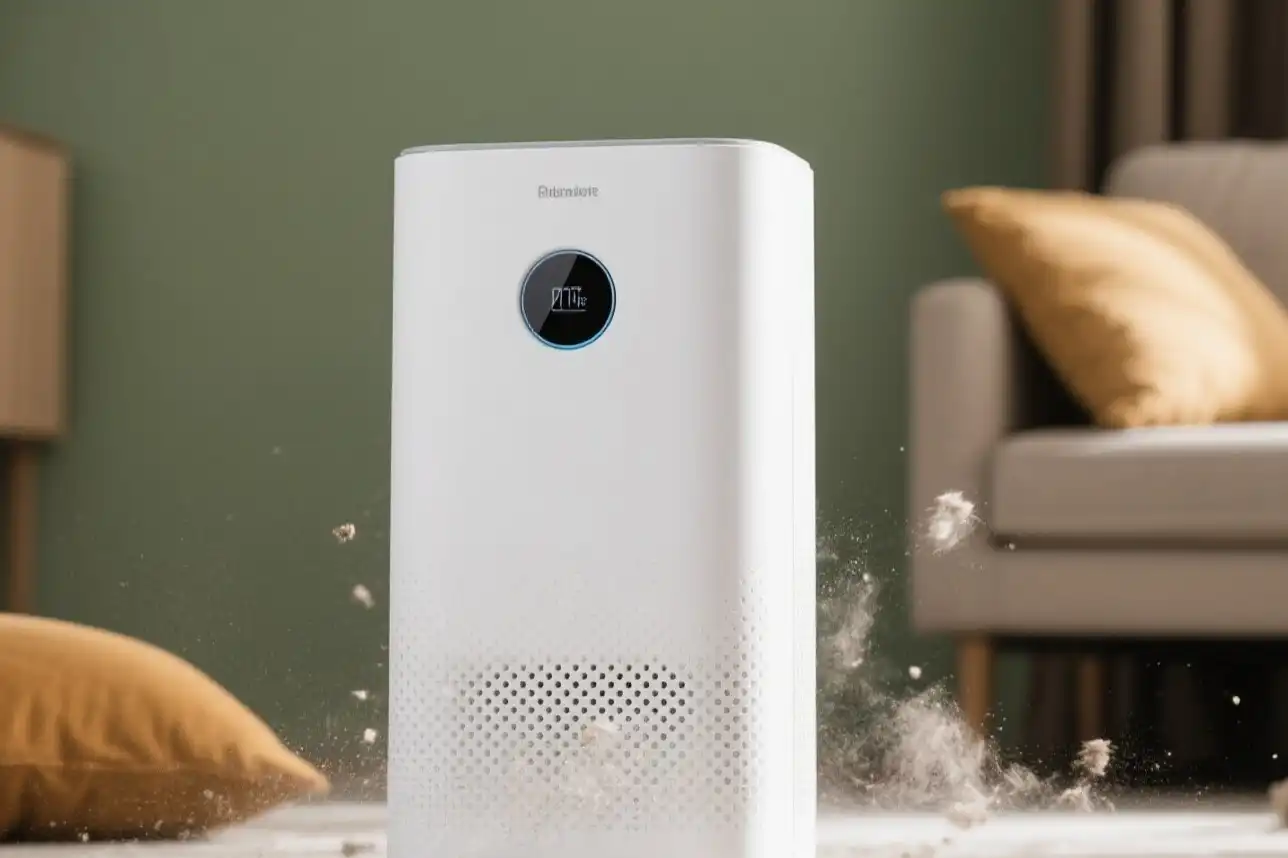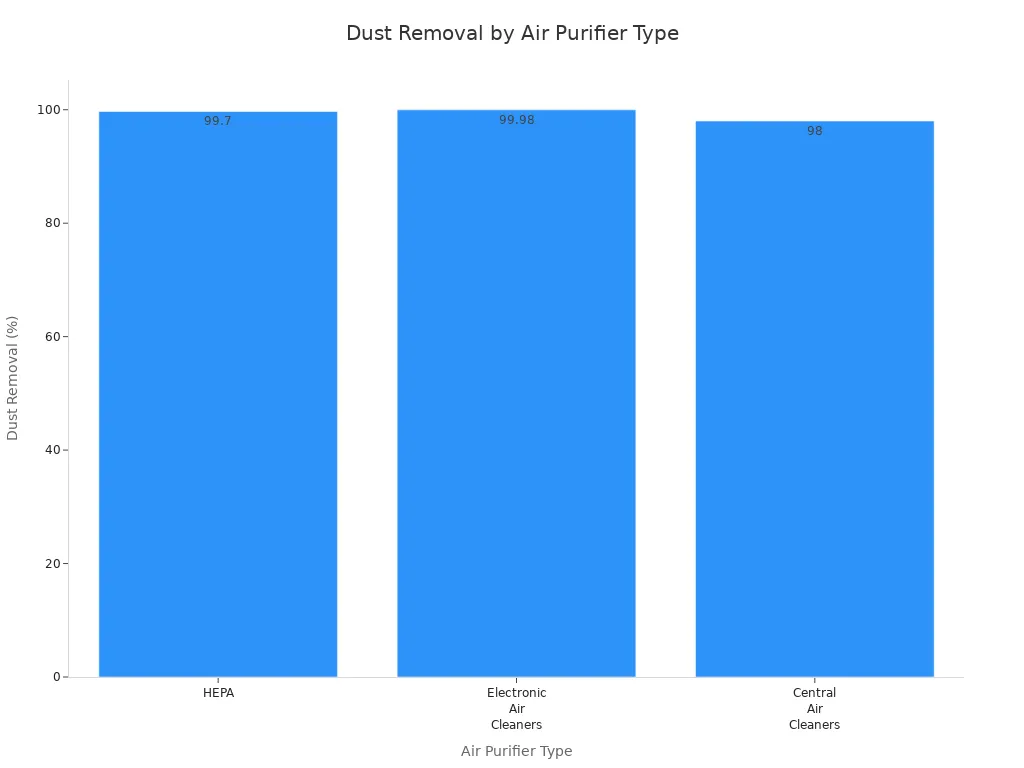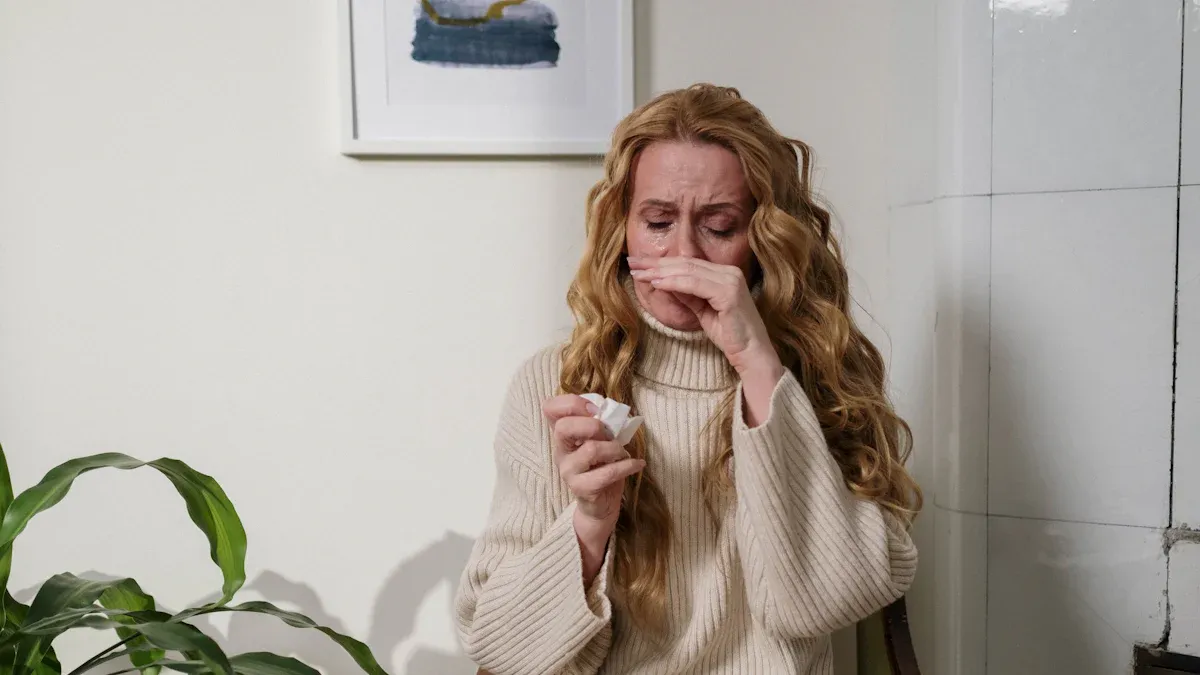
Yes, air purifiers with HEPA filters can really help people with dust allergies. These machines pull air through special filters. The filters catch dust, pollen, and other allergens as small as 0.3 microns. Studies show that HEPA air purifiers can lower dust in the air by up to 80% in homes.
| Source/Study Type | Particle Size Range | Percentage Reduction in Airborne Dust Particles |
|---|---|---|
| U.S. EPA (official data) | Particles ≥ 0.3 microns | At least 99.97% removal efficiency |
| Clinical Study | 18-514 nm | About 98% removal efficiency |
| Randomized Controlled Trial | General particulate matter | Average 50% reduction |
| Additional Study (Du et al.) | General particulate matter | 69% to 80% reduction |
The Air Purifier and Dust Removal Effect depends on keeping the filter clean and putting the purifier in the right spot. Cleaner air inside helps lower allergy symptoms and is good for your breathing.
Key Takeaways
- HEPA air purifiers catch almost all tiny dust in the air. This helps lower allergens a lot.
- Use an air purifier in closed rooms for best results. Keep its filter clean to help you breathe better and have fewer allergy problems.
- Air purifiers take away dust and pet dander from the air. They cannot clean dust mites or allergens from your bed or couch.
- Pick an air purifier that matches your room size. Put it where nothing blocks the air flow for the best effect.
- Wash bedding in hot water often. Keep the air dry and clean your home a lot to help with dust allergies.
How Air Purifiers Remove Dust

Filtration Process
Air purifiers use science to catch dust and other tiny things in the air. The most common way is called mechanical filtration. Air goes through a thick mat of fibers. Big dust pieces get stopped by the fibers. Smaller dust gets stuck as air moves through the filter. Electrostatic filtration gives extra help. Special fibers with a charge pull in and hold small and medium particles like dust and pollen. Some air purifiers have activated carbon filters too. These filters grab smells and gases and hold them on the carbon.
The table below explains the main ways filters work:
| Filtration Principle | Description |
|---|---|
| Sieve Effect | Particles bigger than the spaces in the filter get blocked. |
| Inertial Mass Effect | Heavy particles moving fast hit the fibers and get trapped. |
| Interception Effect | Fibers pull in small particles that stick to them. |
| Diffusion Effect | Tiny particles move in random ways and bump into fibers. |
New technology has made air purifiers work even better. Nanofiber filters can catch very tiny particles. Hybrid filters mix HEPA, activated carbon, and germ-killing layers for better cleaning. Smart air purifiers use sensors to change settings by themselves. This makes them work better and easier to use.
HEPA Filter Role
HEPA filters are very important for getting rid of dust. In the U.S., a real HEPA filter must catch at least 99.97% of particles that are 0.3 microns big. This size is hard to catch, so it is used for testing. HEPA filters often do even better with bigger or smaller particles.
| Certification Standard / Source | Minimum Particle Size Certified | Efficiency Requirement | Notes |
|---|---|---|---|
| U.S. Department of Energy (DOE) & ASME | 0.3 microns (μm) | ≥ 99.97% | This is the main rule for HEPA filters in the U.S. |
| ISO & European Standard | 0.3 microns (μm) | ≥ 99.95% | Europe uses a similar rule but with a tiny difference |
| EN 1822 & IEST RP-CC001 | 0.3 microns (μm) | ≥ 99.95% | These rules sort HEPA filters into groups (H13–H14) |
HEPA filters use different ways to trap dust. The fibers stop big pieces, pull in smaller ones, and catch the tiniest dust by random movement. Medical H13 HEPA filters can even trap things as small as 0.05 microns. Some new air purifiers mix HEPA with other tech, like UV light or ionization, to clean even more dust.

Tip: For best results, pick an air purifier with a real HEPA filter and keep it clean. This helps remove the most dust and allergens from your indoor air.
Efficiency for Dust Allergies
Air purifiers help people with dust allergies a lot. True HEPA filters trap at least 99.97% of tiny particles, even those as small as 0.3 microns. This means most dust, pollen, pet dander, and mold spores get caught before you breathe them in. Medical-grade HEPA filters, like H13 and H14, can catch even more, up to 99.995% of these tiny things. This high level of cleaning helps stop allergy symptoms and makes breathing easier.
Many studies show air purifiers make indoor air cleaner and help with allergies. One big study found that kids with asthma had fewer problems when they used HEPA air cleaners in their bedrooms. Another study showed people with dust mite allergies needed less medicine after using HEPA air purifiers. Some research found that air purifiers can lower swelling in the airways and help people with allergies breathe better.
Scientists tested air purifiers in real homes. They saw that these machines can lower PM2.5 (tiny dust) inside by up to 72.4%. In one study, rooms with closed doors had 57% less PM2.5 after 48 hours of using an air purifier. These results show air purifiers work best in closed rooms with not much indoor pollution.
The table below shows how well HEPA air purifiers lower common allergens:
| Allergen Type | Particle Size Association | Reduction Efficiency by HEPA Air Purifiers | Statistical Significance |
|---|---|---|---|
| House Dust Mite (HDM) | Mostly >10 μm, also in PM2.5–10 | Der f 1 reduced by ~75.2% | p < 0.001 |
| Cat Dander (Fel d 1) | Mostly in PM2.5–10 | Reduced by ~76.6% | p < 0.01 |
| Dog Dander (Can f 1) | Mostly in PM2.5–10 | Reduced by ~89.3% | p < 0.01 |
| Mold Spores | Not specifically addressed | N/A | N/A |
HEPA filters catch allergens from both big and small particles. About half of dust mite allergens float on particles smaller than 10 microns, which HEPA filters can trap. Pet dander, which often causes allergies, sticks to small particles that these filters remove easily.
Note: Air purifiers do not remove dust mites or allergens from beds, carpets, or furniture. These machines only clean the air, not surfaces. People should still wash bedding in hot water and keep the air dry for best results.
Particle Size Capture
Air purifiers work by trapping particles of many sizes. HEPA filters are best at catching 0.3 micron particles, but they also grab bigger and smaller ones. This matters because dust, pollen, and pet dander come in different sizes. Some new air purifiers can even catch particles as small as 0.1 micron with 99.5% efficiency. A few can remove particles down to 0.003 microns, which includes some bacteria and viruses.
- The Advanced HEPA+ air purifier removes 99.97% of particles bigger than 0.3 microns and 99.5% of particles bigger than 0.1 micron.
- It has four filters: a pre-filter for big stuff, a medium filter, an activated carbon filter for gases, and a true medical-grade HEPA filter.
- This system catches dust, dust mite allergens, pollen, pet dander, mold spores, bacteria, and viruses.
- High airflow and a 360° intake help clean the whole room, making the air purifier work even better.
How well an air purifier works also depends on how you use it. Keeping doors and windows closed helps it clean the air better. Changing filters often keeps the purifier working well. But air purifiers cannot remove dust that has settled on things. They also cannot replace other ways to control allergies, like cleaning and using dust-proof covers.
Tip: For the best results, use the air purifier in closed rooms, change filters often, and clean your home regularly.
Understanding Dust Allergies

What Is Dust
Household dust is made of many small pieces. These pieces come from inside and outside your home. Some common things in dust are fabric fibers, skin flakes, animal dander, pollen, and mold spores. There can also be tiny bugs in dust. Dust has dust mites, bacteria, and sometimes parts of cockroaches. Most of these things land on carpets, curtains, and furniture.
Dust comes from many places:
- Dirt from outside gets tracked in
- Skin flakes and hair from people
- Dander, spit, and pee from pets
- Pollen and mold spores
- Dust mites and their droppings
- Cockroach poop and body parts
- Fibers from clothes, bedding, and furniture
Other things that make dust are cooking, cleaning, and burning candles. Some building materials can put chemicals into the air. Old houses might have asbestos fibers in the dust. Air pollution from outside can also get in through windows and doors.
Kids touch dust more because they play on the floor and touch things where dust gathers.
Allergy Triggers
Not all dust makes people have allergies. The main thing that causes dust allergies is the dust mite. Dust mites are tiny bugs that like warm, wet places like beds, mattresses, and soft furniture. They eat skin flakes from people and pets. The proteins in their bodies, old skins, and poop float in the air when moved. These proteins can make many people have allergies.
Dust mite allergens can make you sneeze, cough, have itchy eyes, or get asthma. Studies say up to 45% of kids with asthma react to dust mite allergens. Pollen allergies happen in certain seasons, but dust mite allergies can happen all year.
Other things in dust that cause allergies are:
- Pet dander from skin, spit, and pee
- Mold spores
- Cockroach pieces
Dust mite allergens stay in your home even after the mites die. This means dust mite allergies can bother you all year. Using special covers and keeping the air dry can help lower your risk.
Tip: Clean often, wash bedding in hot water, and use air purifiers with HEPA filters to help with dust allergy symptoms.
Choosing and Using an Air Purifier
Key Features
Picking the right air purifier helps with dust allergies. Medical-grade HEPA filters, like HEPA-PURE, trap tiny dust mite allergens. Some purifiers have special treatments on the filters to catch more allergens. It is important to match the purifier’s size to your room. For example, a BreatheSmart FLEX works for rooms up to 700 square feet. Bigger rooms need a larger purifier. Quiet models, such as those with WhisperMax technology, are good for bedrooms. Many purifiers now have apps to check air quality and filter life.
Other useful features are:
- Smart sensors that change settings by themselves
- Different fan speeds for different needs
- Energy-saving designs that use less power than a light bulb
Tip: Use an air purifier, wash bedding in hot water every week, use dust-mite-proof covers, and keep humidity under 50% to control dust mites.
Placement Tips
Where you put the purifier matters a lot. Make sure nothing blocks the airflow. Leave at least 3 to 4 feet of space around it. Put the purifier near doors, windows, or where pets are. This helps catch dust before it spreads. In bedrooms, place the purifier close to your bed for better air at night. Do not put it near electronics or in damp places. Moisture can make the filter work less well. Lifting the purifier 3 to 5 feet off the floor helps catch heavier dust.
A study from 2023 found that blocked airflow can make purifiers work 63% less well. Putting purifiers near doors can lower outdoor dust by 60%. Make sure the Clean Air Delivery Rate (CADR) matches your room size so the purifier works right.
Maintenance
Taking care of your air purifier keeps it working well. Change HEPA filters every 6 to 15 months, or as the maker says. Some filters last up to 2 years. If you hear noise or see dust, it is time to change the filter. Cleaning or changing filters on time stops clogging and keeps dust removal strong.
Using the purifier all the time and cleaning your home often gives the best results. Air purifiers clean dust in the air but not dust on things. Keeping up with care helps the air stay clean and lowers allergy problems.
Air purifiers with HEPA filters can help people with dust allergies. These machines lower dust in the air and make breathing easier. Studies say they work best if you also clean your home often. You should still dust and vacuum to get rid of dust on things. Health experts say to pick a purifier that fits your room size. Put it in the right spot and keep the filter clean.
- Air purifiers cannot take the place of dusting or vacuuming.
- One air purifier is made for just one room.To have cleaner air and fewer allergy problems, use an air purifier, clean your home often, and follow good habits at home.
FAQ
How often should someone run an air purifier for dust allergies?
Most experts recommend running an air purifier all day for the best results. Continuous use helps keep dust levels low. Turning it off allows dust to build up again.
Can air purifiers remove dust mites from furniture or bedding?
No, air purifiers only clean the air. Dust mites and their waste stay on surfaces like beds and couches. Washing bedding in hot water and vacuuming helps remove them.
Do air purifiers help with pet dander allergies?
Yes, HEPA air purifiers trap pet dander floating in the air. This reduces allergy symptoms. They do not remove dander stuck to carpets or furniture.
What size air purifier works best for a bedroom?
Choose an air purifier that matches the room size. For most bedrooms, a unit rated for 150–300 square feet works well. Check the Clean Air Delivery Rate (CADR) for better results.
See also
What to Consider Before Getting an Air Purifier
What Factors Cause Air Purifiers to Worsen Allergies
How to choose the right filter for your air purifier
What Science Says About Air Purifiers for Sinus and Allergy Symptoms
